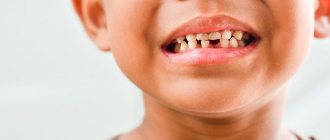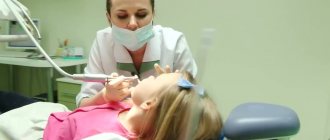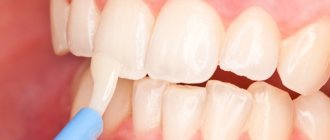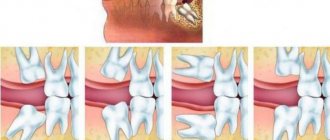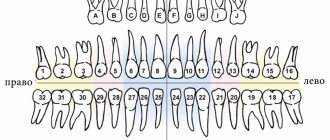Each person goes through the stages of the eruption of the first teeth, the development of milk teeth and their subsequent replacement by permanent ones. Despite their similar appearance and function, temporary and permanent teeth have differences, which we will talk about, at the same time we will consider the timing of the appearance of the main teeth, possible problems with them in the process of their development.
The photo shows a diagram of the structure of human teeth
The structure of human teeth
Teeth are not only intended for mechanical processing of food, but are also necessary for the formation of speech, breathing, and influence facial features. To navigate what dentists advise, how to take care of your teeth, and what the risks of disease are, it is useful to know how they work.
Anatomical structure
3 parts that make up a tooth:
- Crown. The visible part of the tooth used for chewing. The outside is covered with durable enamel, which protects it from bacteria, chemicals contained in food, water, and saliva. The surfaces have their own names: Facial (vestibular) - in contact with the lip or cheek.
- Lingual (lingual) – the opposite of the facial, involved in the formation of speech.
- Occlusion – the upper surface in contact with the tooth of the opposing jaw.
- Contact (approximal) – contacts with adjacent teeth.
Milk teeth, having a largely similar structure, also have differences in anatomy:
- They are noticeably smaller in height than permanent ones.
- The crown is much wider than the root.
- Enamel is thinner and more fragile.
- The roots are more round.
- The wear of baby teeth, as well as their spontaneous loss, is a normal physiological process.
Histological structure
The structure has several layers:
- Enamel is the most durable fabric. When a tooth just erupts, a cuticle is located on it, which is gradually, under the influence of saliva, replaced by a pellicle.
- Dentin is a highly mineralized tissue that resembles bone, but has better mechanical strength. Instead of enamel, the root part of the dentin is covered with cement.
- The pulp, the central part of the tooth, is a soft connective tissue containing a large number of blood vessels. Caries and inflammatory processes “owe” pain to the pulp with its large number of nerve endings.
Milk teeth are distinguished by dentin with a lesser degree of mineralization, which weakens their protection against caries. The volume of pulp occupies most of the tooth, and small protective layers (enamel and dentin) provide less protection against the penetration of bacteria and the development of inflammatory processes.
Types of teeth
There are 4 groups:
- Incisors. 4 chisel-shaped cutters. The largest are a pair of upper central incisors, and the situation is opposite from below - the lateral incisors are slightly larger than the central ones.
- Fangs. 2 on the upper and the same number on the lower jaw. Their length is longer than the others, the front wall is convex.
- Premolars. There are 8 in total, prismatic in shape, the upper surface with two tubercles (buccal and lingual). Premolars have 2 roots. The second premolar has a larger buccal surface. There are no primary premolars.
- Molars. The first molar (molar) is the largest tooth in the upper jaw. The chewing surface has four tubercles, 3 roots. The cubic-shaped second molar is smaller, and the buccal tubercles are larger than the lingual ones. The third (“wisdom tooth”) is in many ways similar to the second, but not everyone has it.
What not to do?
The following rules will help you avoid bite problems and the appearance of various defects:
- do not allow your child to loosen his teeth if they are not yet going to fall out and are firmly in place;
- teach your child not to touch a loose tooth with dirty hands (and, of course, he should not pick the hole when the tooth has just fallen out);
- Do not give your child a lot of solid foods during the period of bite changes. This way he can break a baby tooth;
- do not fill the hole after tooth loss with alcohol;
- You shouldn’t make fun of your child’s temporary toothlessness.
Dental formula
In order to improve the convenience of describing each tooth, numbering them, and filling out cards, it is customary to record the order of the teeth using a special formula. There are several varieties of it.
Zsigmondy-Palmer system (quadratic-digital)
Arabic numerals are used, numbering starts from the central incisors in each direction:
- 1 and 2 – incisors.
- 3 – fang.
- 4, 5 – premolars.
- 6-8 – molars.
Milk teeth are designated differently - using Roman numerals:
- I and II – incisors.
- III – fang.
- IV and V – molars.
Two-digit Viola system
Teeth numbering uses 2 digits. The jaws are divided into 4 quadrants. The first digit shows its number.
For adults this is:
- 1 – upper jaw on the right.
- 2 – upper jaw on the left.
- 3 – lower jaw on the left.
- 4 – lower jaw reference.
For a similar description of baby teeth, numbers 5 to 8 are used.
So, there are 8 teeth in each quadrant, its number is shown by the second digit. Thus, the first molar of the lower jaw on the left is designated 35, and the child’s canine from the lower right is designated 43. Therefore, the phrase that “treatment of the 48th tooth is required,” or, for example, the 55th, does not indicate the doctor’s lack of qualifications or what - or pathology in your child, who suddenly acquired so many teeth.
Universal system
It was developed in 1882 by Jesus Perreidt. To this day, this numbering method remains the simplest. Each tooth has its own specific number. The American Dental Association (ADA) approved this system in 1975. Since then, it has been a staple in US dental clinics.
Number 1 in the ADA system was given to the upper right molar. The remaining teeth are numbered clockwise from it. The lower right molar has the number 32. There are two designations for primary teeth - in Latin letters from A to T or numbers from 1 to 20 with the letter d.
Despite the apparent simplicity of the ADA system, it has a significant drawback. The number does not correlate with any anatomical features, so they need to be remembered. An advantage of the method is the convenience of notation on computer models.
Dental development
The differences between primary and molar teeth begin with their number - only 20 primary teeth, 8 incisors and molars, and 4 canines. This is explained by the fact that children simply have nowhere to fit more teeth. In this regard, there are no primary premolars. By the time the permanent teeth appear, the adolescent's jaws are already sufficiently developed for all teeth to appear.
The formation of tooth buds in humans begins at the 6th week of intrauterine development, and at the 14th week hard dental tissue appears. The crown develops first. The development of the rudiments of permanent teeth begins in the 5th month.
By the time a child is born, the formation of the rudiments of both milk and permanent teeth is almost complete. The process of development of permanent teeth, which have no analogues among milk teeth, begins a year after birth.
While the first teeth may appear at 4 months, and their eruption may be delayed for up to a year, permanent teeth erupt in everyone at approximately the same age. The sequence of their eruption is the same as in the case of milkweeds:
- 6-7 years. The central incisors appear from below.
- 7-8 years old. The central incisors on top and the lateral incisors on the bottom are replaced.
- 8-9 years old. The lateral incisors of the upper jaw appear.
- 9-12 years old. Canines and premolars are replaced.
- From the age of 12. From this age, molars begin to change, and from about 14 years of age, teeth appear, which were not among the milk teeth.
How many baby teeth does a child have?
The first baby teeth appear in children aged 5-8 months. In rare cases, a tooth can erupt at 2-3 months, as well as during the neonatal period. In premature infants, as well as children with metabolic disorders and genetic predisposition, the first teeth may appear around 10-12 months. Late teething can be considered a variant of the norm if the child does not have signs of rickets - a systemic disease in which the transport of calcium and phosphorus to the bone and other tissues of the child’s body is disrupted and these elements are no longer absorbed in the volumes necessary for the healthy functioning and growth of the musculoskeletal system. Rickets in childhood can lead to increased fragility of bones and their destruction (osteoporosis), therefore, if by the age of one year the baby has not developed a single tooth, you should consult a doctor.
In total, a child should have 20 milk teeth - in the absence of pathologies and metabolic disorders, this occurs before the age of 2.5-3 years. Medicine knows of cases where at one and a half years old children had 18-19 teeth in their mouths. This may also be a variant of the individual norm if pathologies of the development of the maxillofacial skeleton are excluded.
Signs of the imminent appearance of molars
You can determine when you should soon wait for the baby teeth to begin replacing with permanent teeth based on several signs:
- The gradual growth of the baby's jaws leads to increasing gaps between the teeth.
- The tooth begins to wobble. This is due to the fact that the already small root begins to gradually dissolve, causing the fixation of baby teeth to be significantly weakened.
- A fallen tooth indicates that the formed permanent one, which is about to appear, pushed it out.
- Swelling and redness may appear on the gums at the site of the eruption of a permanent tooth.
- Pain in the gums, where the permanent tooth erupts, increased temperature, and poor health of the child indicate problems have arisen, and it is necessary to see a doctor. The process of erupting molars should be painless.
Painful teething: advice for parents
When faced with teething in children, many parents are at a loss. First of all, you need to call an ambulance and determine the reason for the baby’s poor health. If symptoms are confirmed, the specialist will prescribe medications for teething - antipyretics and painkillers.
You can treat your gums yourself with an anesthetic gel with a cooling effect to reduce itching and swelling of the mucous membrane. Ice will also help. To reduce gum irritation, there are special silicone fingertips made of hypoallergenic material.
Folk remedies for teething will effectively relieve painful sensations - a decoction of chamomile, sage, tincture of valerian and honey will soothe inflamed tissues.
Painkillers for teething are contraindicated in children; this can worsen their health.
Important!
Without a doctor's recommendation, antibiotics and other strong teething medications can cause an allergic reaction.
Possible problems
At the moment the molars appear, certain dental problems are possible. In order to take timely measures to eliminate them, parents must have an idea about them.
Molars do not erupt
A situation is possible in which baby teeth do not fall out in a timely manner, or they have fallen out, but molars have begun to appear in their place. The reason for this must be determined by the dentist, who must be visited without delay. A general x-ray is usually taken to show the degree of development of the molars.
Among the options for the lack of eruption of molars in due time can be indicated:
- Hereditary predisposition, which is the cause of a possible delay in the appearance of molars. If the x-ray shows that the process of forming the rudiments of teeth is underway, then you will just have to wait a little for their appearance.
- Adentia. Disturbances in the processes of formation of tooth germs during the intrauterine development of a child, inflammatory processes can lead to a similar pathology - the absence or death of tooth germs. The solution is prosthetics.
Pain
The first time after teething, the tooth is poorly protected from caries and the effects of various bacteria. This is explained by the low degree of enamel mineralization at the initial stage. Almost nothing interferes with the development of caries; tooth tissue is destroyed, pulpitis occurs, with the subsequent risk of its transition to periodontitis. Severe pain, changes in body temperature and deterioration in well-being may occur.
It is highly advisable not to let the situation get worse, not to cause severe pain, but to visit a dentist as soon as painful sensations appear. If a child is predisposed to caries, it is better to carry out preventive procedures, for example, fissure sealing. The folds on the chewing surface are covered with a composite material that protects such natural cavities from the accumulation of food debris in them, the development of bacteria, and inflammatory processes.
In the worst case, you can lose a tooth.
Teeth grow crooked
A common situation is when the molar has already begun to erupt, but the baby tooth does not want to fall out. The result is that the new tooth seeks alternative growth paths, which leads to its displacement and change in the direction of growth. Hence the malocclusion and the alignment of the dentition. Treatment by an orthodontist will be required.
If this situation occurs, you should not remove or loosen a baby tooth yourself; you should visit a doctor.
Loss of molars
An alarming symptom of the presence of diseases (caries, etc.) in the oral cavity, or there are problems with the entire body (connective tissue diseases, diabetes, etc.). A visit to the doctor is mandatory.
This is necessary to develop a strategy for restoring a lost tooth. This is necessary for the proper growth of the remaining teeth and the formation of the maxillofacial system. Considering that the jaw tissue is still in the process of growth, prosthetics are only possible temporary, which must be adjusted as the jaws develop. Permanent prosthetics will be available only after their formation is completed.
Injuries
The first few years after teething, teeth are at increased risk of injury from impact. Sports injuries, falls, and blows can lead to chipping of parts of the tooth and cracks. Be sure to contact a dentist who will restore the lost part with modern materials.
Deviations from the norm
After the mother has become familiar with the necessary sequence of growth of the child’s teeth, it is necessary to exclude the presence of deviations. There are cases where tooth growth is delayed or does not occur according to plan, and this is the norm. But sometimes doctors can say that deviations are pathological. How to determine what is normal and what is not?
Early appearance of teeth
If you think that your baby teethed very early, then you should think about the specificity of the hereditary predisposition or thyroid disease.
A rather rare but existing situation is when a baby is born with an existing incisor. In medical practice, such a manifestation occurs very rarely; it indicates a hormonal imbalance in the body. If there is a defect, it is more advisable to visit an endocrinologist to receive qualified treatment.
Late appearance of teeth
Young mothers sound the alarm when the child’s first tooth makes itself felt only at the end of the first year. However, medical specialists do not always consider this course pathological. If children are missing at least one tooth per year, it is more advisable to visit a dentist and pediatrician.
An interval between tooth formation lasting more than 60 days is considered abnormal. In this case, the defect is due to a reduced calcium content, poor absorption of vitamin D and other pathologies.
Key concepts in tooth classification
Each person normally has 20 primary and 32 permanent teeth. They are designed for biting, tearing and chewing food. The shape and structure of teeth is largely determined by their physiological function.
Some teeth have lost their functionality in the process of human evolution. Thus, wisdom teeth of the upper or lower part of the skeletal system often erupt in adulthood and may have an atypical location.
The higher incidence of premature removal of extreme molars is associated with their late eruption and abnormal location in the bone tissue.
International numbering designation
Often the dentition, numbered starting with 1 or 2, belongs to the upper jaw. And the initial numbers 3 and 4 serve to designate the teeth of the lower jaw.
Types of teeth
In dental practice, depending on the structure and structure, the following categories of teeth are distinguished:
- Incisors. These organs are located in the central part of the maxillary and mandibular bones, four at the top and four at the bottom. They have a flat shape, a sharp edge and a straight root. Incisors are designed to separate the primary piece of food.
- Fangs . They have a massive coronal part with a sharp cutting edge and a pronounced root. Four canines are located behind each lateral incisor. Their function is to tear off solid food particles.
- Premolars . The two teeth on each side of the jaw that follow immediately after the canines are called molars in dentistry. They usually take part in the processes of chewing food.
- Molars. Due to their chewing surface, they ensure complete grinding of food particles. There are three on each side of the jaw.
Main groups of teeth:
| Type | Image |
| Incisors | Upper central incisor |
| Fangs | Fang configuration |
| Premolars |
|
| Molars |
|
How are teeth numbered in dentistry? The dental formula shows the location and type of each tooth.
Jaw segments
The human dental system has a relatively symmetrical structure. The right side of each jaw mainly corresponds to that on the left side. According to the international classification of dental anomalies, the upper and lower jaw form four segments (upper right, upper left, lower left and right).
In dentistry, the scheme for adults necessarily takes into account all four segments of the jaws. This classification allows us to detail the localization of teeth. The first digit in each numbering system typically indicates the name of the segment, which are designated by numbers in a clockwise direction from top right to bottom right.
Digital value of segments of the maxillofacial region
Care instructions
Molars in children require even more careful care than in adults. Frail enamel is much more susceptible to the effects of carious bacteria and the external environment, and the love of sweets and carbonated drinks does not add strength to it. When children develop a permanent bite, parents need to take special control of oral hygiene and diet (at least until the age of 14–15, when the teenager himself begins to realize the importance of dental health). In general, there are no difficulties here: in order to keep children's teeth strong and healthy, you need to follow several basic points.
- Daily hygiene.
Brush your teeth at least twice a day, use dental floss and special rinses. - Proper diet.
Limit your intake of sweets and carbohydrates. - Preventative visits to the dentist at least once every six months.
If necessary, fluoridation and sealing of molars in children (so-called fissure sealing). - Do not forget to wear a protective mouth guard during active games and sports.
